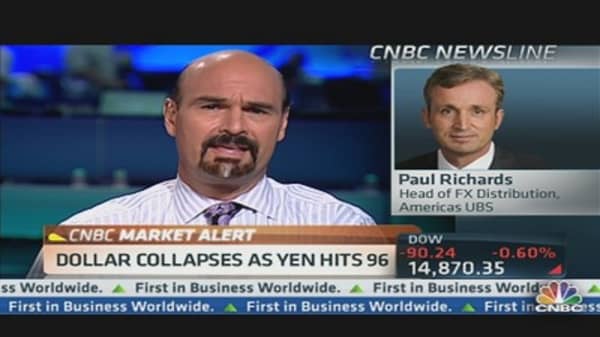Traders attributed market jitters to several factors: A speech earlier by European Central Bank leader Mario Draghi, who seemed to indicate that further monetary easing was not imminent; political turmoil in Turkey; and an anticipation that Friday's U.S. nonfarm payrolls report was likely to disappoint.
(Read More: ECB Holds Rates and Cuts Growth Forecast)
Then, just like that, the panic unwound.
Vecchio saw the move as being temporary and predicted the payrolls number would beat expectations.
Within an hour or so, the dollar still traded sharply lower against the yen, but losses had been halved. Equity markets stabilized, with the Standard & Poor's 500 even briefly dipping into positive territory, and order seemingly came back to the markets.
The dollar has been on a downslope lately as economic data have turned weak and fears are growing over whether the Federal Reserve is planning an early exit from its aggressive easing program.
(Read More: Why Bad News Soon May Just Become...Bad News)
But prior to the retreat, it had been moving higher with the stock market, reversing a trend that has been in place for much the post-financial crisis market era.
"Ultimately that's a good sign for the U.S. economy," Vecchio said of the strong dollar-stocks correlation. "That means people believe in the dollar not just as a safe haven but as a growth currency."
The aftereffects of Thursday's blowup, though, had traders wondering if patterns were beginning to change.
"In equity land all of a sudden you're starting to get a perforation, like you're getting ready to tear that sheet," said Michael Gurka, managing director at Spectrum Asset Management. "This could be the beginning of—I don't want to call it a tipping point—but of something unfolding. Was 6/6 the first sign?"
_ By CNBC's Jeff Cox. Follow him @JeffCoxCNBCcom on Twitter.


.530x298.jpg?v=1370447694)


